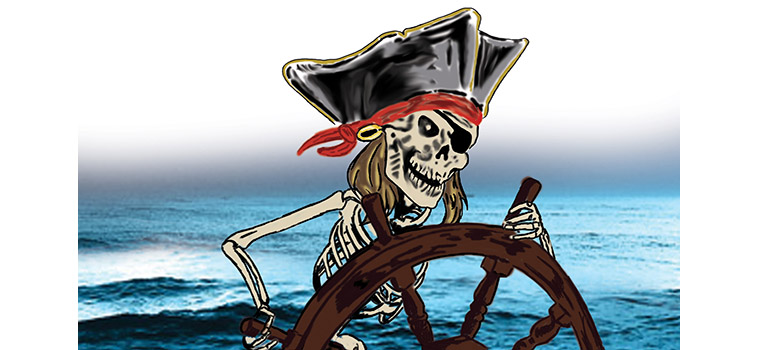It's that time of the year again, which means it's time for my favorite column. September 19 is "officially" Talk Like a Pirate Day. I don't know who decided that or when it was decided, but it is now a tradition.

BY CAPTAIN RAY
Published: September, 2017
It’s that time of the year again, which means it’s time for my favorite column. September 19 is “officially” Talk Like a Pirate Day. I don’t know who decided that or when it was decided, but it is now a tradition. That being the case, here are some everyday phrases and expressions that are reported to have nautical origins. You, too, can “Talk Like a Pirate!”
A prudent navigator (the only kind of navigator you ever want to be), will use whatever tools are available. For the 9th and 10th century Vikings, this included the raven and crow. These are land birds and they are uncomfortable over open water. During periods of reduced visibility, when a navigator was having difficulty determining the course to steer, the ship would release a crow. The bird would inevitably fly toward the nearest land, and the navigator could set his course “as the crow flies.”
The cage of crows was carried near the top of the mast, making it easy for the lookout to release one without having to climb down to the deck. I’m sure you can understand why the lookout’s location at the top of the mast became known as “the crow’s nest.”
There is a street in Yokohama, Japan called Honcho Dori (which roughly translates as Main Street). It runs from the downtown area to the port and would have been very well known to 19th century American sailors, because there were many establishments along this street that catered to the desires of these visiting seamen. In their slang, when everything was good or to their liking, it was said to be “hunky-dory.”
The wind that powers sailing vessels also causes them to lean (or heel) over. Another verb for this is to “list.” When the wind ceased to blow, a sailing vessel has no energy and will sit straight upright in the water, or be “listless.”
For many centuries, flogging was considered a normal form of punishment for the ship’s crew. This was usually done by lashing the unfortunate recipient to an upended hatch grate. Occasionally the punishment would be administered by holding the seaman over the barrel of one of the ship’s great guns. Now, when we are caught in an inescapable situation, we are said to be “over a barrel.”
When we are sad or depressed, we often use the expression “feeling blue” to describe the mood. As blue is not inherently a sad color, how did this linkage evolve? When returning to her homeport, it was the seaman’s practice to paint a blue stripe from bow to stern along the hull and fly blue flags to signal the death of the captain.
Because sailing ships traveled the world while most people did not, they could be the cause of spreading diseases like plague from one location to another. In order to reduce this possibility, arriving vessels were often required to present a certificate to the port officials stating that there was no infectious disease at their last port of call and the crew are all healthy. This was known as “a clean bill of health.”
At the change of the watch and other ceremonies aboard ship, the crew was required to assemble on deck in a proper and orderly alignment. To help with this alignment, they were often instructed to line up along a particular seam in the deck planking. Since common seamen went barefoot while on board during this assembly, they were said to “toe the line.”
Sailors have many terms to describe a vessel’s relationship to the wind. When sailing into the wind with all sails adjusted and extracting the maximum energy from the wind, the ship was said to be sailing full and by (“by” meaning upwind). One of the terms used to denote the same conditions when sailing downwind was to say the ship was sailing “large.” Hence the origin of an expression meaning to cover all circumstances, “by and large.”
Ray Wichmann is a US SAILING-certified Ocean Passagemaking Instructor, a US SAILING Master Instructor Trainer, and a member of US SAILING’s National Faculty. He holds a 100-Ton Master’s License, was a charter skipper in Hawai’i for 15 years, and has sailed on both coasts of the United States, in Mexico, the Caribbean and Greece. He is presently employed as the Master Instructor at OCSC Sailing in the Berkeley Marina.

